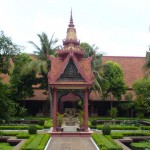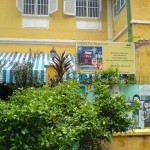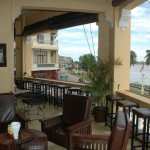Phnom Penh has survived the darkest years of its country’s history and its own near-destruction to become a city of life once again.
Escaped Bangkok for a long weekend in Phnom Penh recently. The capital city of Cambodia is just an hour’s flight away, but the difference between the two cities is remarkable. Bangkok is a vast, chaotic, polluted hub of global commerce; Phnom Penh feels like a quiet backwater in comparison, sleepy but beautiful, still boasting the distinct architecture and sweeping boulevards left behind by the French earlier this century.
When I came to Phnom Penh the first time as a backpacker in 2003, I’d been reading a couple of Cambodian history books like Elizabeth Becker’s When The War Was Over and David Chandler’s Brother Number One: A Political History Of Pol Pot. From those books I discovered how the entire population of Phnom Penh had been forced to leave the city when the Khmer Rouge took power in 1975 – everyone, young or old, sick or infirm, had to leave their homes and go out to work in the fields. Hundreds died in the ensuing chaos, a grim prologue to the genocidal slaughter that followed, and Phnom Penh remained a ghost city for the next four years until the Khmer Rouge were deposed by the invasion of the Vietnamese in 1979. (A visit to the Tuol Sleng genocide museum in southern Phnom Penh and the Killing Fields in the suburbs provides a comprehensive and gutwrenching introduction to the Khmer Rouge’s time in power). What is amazing about Phnom Penh to me is that looking around its bustling streets now, however run down they may seem, you would never know that the city stood silent for four years. That the city has returned to being a city at all is something to be marvelled at and valued.
Photos of Phnom Penh – click for larger images:
We stayed at the Foreign Correspondents Club, the sister to the magnificent FCC Angkor where we’d stayed last year. The FCC is, without exaggeration, at the very centre of Phnom Penh. It’s a longtime favourite expat hangout overlooking the Tonle Sap river and sweeping Sisowath Quay on one side and the National Museum on the other. Even the Raffles Hotel Le Royel doesn’t share such a prestigious location – and the FCC is a lot cheaper to stay at with well-appointed rooms starting around $55US. It’s definitely a step up from the humble digs of the backpacker quarter located around Beang Kak lake in the North of the city.
The FCC’s bar and restaurant is very hard to extricate yourself from once you get settled in the comfy leather armchairs, thanks to the views and the sides of the building being open air – it’s like being in a gentleman’s club on a roofed terrace. It’s a great place to relax for several hours at a time, luxurious without being formal, and has a excellent menu and drinks list too.
When you do decide to venture outside, the FCC’s location mean that most of Phnom Penh’s sights are easy to reach on foot – it’s a short stroll along the banks of the river on the wide, manicured sweep of the Quay down to the towering spires of the Grand Palace and the National Museum next door to it. The Grand Palace is breathtaking, but I found the National Museum to be fascinating. I’ve got a bit of a thing about the Angkor temples, and within the museum lies hundreds of the statues, from huge 10 feet high stone carving to exquisite tiny Buddha images, that have been rescued from the Angkor temples before they could be stolen by tomb raiders. Even if you’re not into looking at the statues, it’s worth paying the couple of dollars to come into the museum and see its sublime courtyard, which is an oasis of tranquility.
Every time you emerge from the door of the building you’ll be beset by friendly touts offering you taxi rides, and indeed, while you’re walking along the road too. It can be a bit wearing but these guys are only trying to make an honest buck, as even Cambodia’s capital is still beset by crushing poverty. It’s apparent everywhere you go – even in the square mile around the FCC which consitutes central Phnom Penh, the showcase area of the city which contains such wonders as the magnificant Grand Palace, the Silver Pagoda and the National Museum, there are many back streets strewn with trash and rubble, and buildings quietly crumbling away. I can’t help feeling there is a sense of melancholy hanging over the city, despite its miraculous revival – not simply because of the awful events of the Khmer Rouge, with the social scars and economic uncertainty that has followed ever since, even two decades later, but also because of what Phnom Penh was in the 1950s and 60s, by all accounts a thriving city of both foreign and Khmer arts and culture, that was all but obliterated by the start of Pol Pot’s Year Zero.
Buy Tickets To Phnom Penh
Use the search box below to find out departure times and prices on your selected travel dates to Phnom Penh.
But there are numerous signs of regeneration and innovation in Phnom Penh too. Down on Road 240 behind the Grand Palace is a whole collection of shops specialising in hand made silks, handbags, belts and other clothes, along with some good second hand bookshops and great cafes. Indeed, food seems to be the heart of cultural life in Phnom Penh – there is a plethora of great restaurants here, several of which are actually charities whose profits go to helping street kids, along with training staff to become chefs and caterers so they can get prestitious jobs with the international hotels around the city. It’s these sorts of initiatives that provide immediate, practical help for a lot of people in Cambodia and help them achieve self-sufficiency so that they themselves can eventually start their own businesses and help others. The Friends restaurant on Soi 13, just by the National Museum, is particularly good – brightly painted inside with lots of local artwork on the walls, the restaurant serves up an excellent array of tapas dishes, the proceeds of which go to look after hundreds of street kids. (You can read more about their work at streetfriends.org).
Whereas other Asian capitals like Bangkok and Ho Chi Minh City seem to be in a permanent state of messy,vibrant reconstruction and transformation, Phnom Penh feels a little like a time capsule, a city whose evolution has slowed down so as to be almost un-noticable. For tourists, this is great, because it means there are colonial streets in picturesque decline to wander – whether it’s so good for the locals I’m not so sure. Here’s hoping that the city continues to attract more foreign investment that helps the locals and speeds up the city’s transformation without ruining its impressive architectural heritage.











